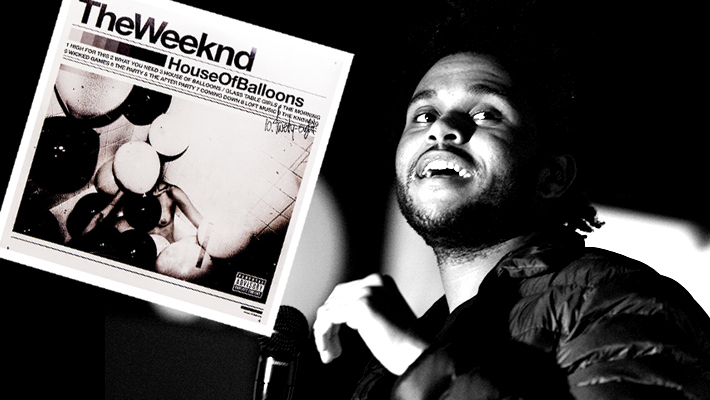“Trust me girl / You’ll wanna be high for this.” Quite the bold statement coming from someone who you couldn’t even make out in a crowd.
The lyrics from “High For This,” The Weeknd’s House Of Balloons opener, embody everything the artist stood for: drugs, dependency, and defenselessness. It’s hard to picture The Weeknd (born Abel Tesfaye) as anything but an international megastar. But upon the release of his debut mixtape, which celebrates its 10th anniversary today, he was merely a faceless enigma.
At the time, no one knew what a “The Weeknd” was. It was unclear if Drake’s right-hand producer Noah “40” Shebib was behind it after Drake’s manager Oliver El-Khatib posted a handful of The Weeknd’s songs on the OVO blog in 2010. Critics didn’t know if it was a solo act or an R&B group, and fans only saw shadowy black-and-white photos he posted during the mixtape’s rollout. Even the cover art was obscure, featuring a woman in a bathtub whose face was hidden by balloons with only her left breast exposed. All we had was a voice: a light tenor that could go from sweet to dangerous in a quick octave change. The mystery looming over his artistry is what lured listeners in.
“In the beginning, I was very insecure. I hated how I looked in pictures,” Tesfaye revealed in 2013’s career-first interview with Complex. “I was very camera shy. People like hot girls, so I put my music to hot girls and it just became a trend. The whole ‘enigmatic artist’ thing, I just ran with it. No one could find pictures of me. It reminded me of some villain shit.”
And what a villain he was. Rather than the typical monster you see in action films, House Of Balloons introduced Tesfaye as a villain who forced the gloomiest parts of your life into the spotlight.
The mixtape’s title is ironic: a balloon-filled house sparks images of carnival-like bacchanal. But it compared despair to a straggler that simply won’t leave the party. The Weeknd’s music was as captivating as it was chilling, as he utilized his Michael Jackson-inspired falsetto to reveal a revolving door of emotionless sexual escapades that were often brought on by drug binges.
The general public was introduced to The Weeknd when he packaged his 2011 mixtapes (House Of Balloons, Thursday, and Echoes Of Silence) into the major-label Trilogy re-release the following year. But listening to the House Of Balloons mixtape is the only way to ingest its authenticity (he’s since tweeted the original release with its intended mixes and samples will be on all streaming platforms on Sunday).
On Sunday for its 10 year anniversary I’m releasing House of Balloons on all streaming platforms for the first time in it’s original incarnation. With the original mixes and samples. ? pic.twitter.com/Wi3joxt1fq
— The Weeknd (@theweeknd) March 17, 2021
Aaliyah’s “Rock The Boat” sample that opens “What You Need” adds to its seductive allure as Tesfaye puts on his dirty macking best. The ending of “The Knowing” is more explosive as he confronts both his and his girl’s infidelities. The singer shares his adoration for dream-pop duo Beach House, as their 2008 song “Gila” is the base for the uncharacteristically heavenly “Loft Music” and “The Party & After Party” samples 2006’s “Master Of None.”
“The Party & After Party” is a nearly eight-minute-long opus, with The Weeknd promising that he’ll provide his girl with an endless supply of cocaine and sex. The track turns sadder and more manipulative in the second half. “Gimme right attention or I’ll start drowning from my wrist,” he mutters. It’s a bleak moment that reveals just how dependent he is.
And of course, there’s the definitive trio: “High For This”, “Wicked Games” and “House Of Balloons / Glass Table Girls.” The heart-stopping production of “High For This” isn’t as glossy as the re-released version, with the singer handholding a fearful lover into a world filled with drugs. “Wicked Games” (no relation to Chris Isaak’s 1989 hit) is him at his most vulnerable and sleaziest. Sex is a transactional tool to mask shame, trading it for a baseless promise of fame.
“House Of Balloons / Glass Table Girls,” which has since become The Weeknd’s signature song, is the mixtape’s highlight. This mix is actually glitchier than the mastered version; laid atop a heavy sample of Siouxsie And The Banshees’ 1980 single “Happy House,” “House Of Balloons” is chaotic in its debauchery. It’s peak euphoria that is accented by the rattling bassline, needle-sharp synths, and that hair-raising falsetto. The rapid comedown occurs on “Glass Table Girls” as the singer darkly urges girls to test out the 707 glass tabletops. His creepy advances are bolstered by woozy bassline and chopped & screwed vocals. Singing about drugs isn’t new in music, yet The Weeknd personalizes it with self-deprecation as he shamefully reveals predatory instincts.
House Of Balloons is frightening in its relatability. It forced listeners to confront the loneliness they feel after realizing partying is the only thing that sustains them. There’s no joy in watching the sunrise on the loft’s rooftop. Rather, its harsh sunlight calls attention to bloodshot eyes, a parched mouth following endless rounds of alcohol, a red nose caked with residue, and overall desperation. I can say this all because I was just as reckless. Being only a year younger than Tesfaye, we had parallel coming-of-age experiences: dabbling in similar substances, using all-night college parties as escapism from depression, and ultimately sought comfort in a mixtape that targeted a shared despondency.
The mixtape reflected a doomed generation who grew up with films like Kids, Trainspotting, Requiem For A Dream, and A Clockwork Orange. We didn’t want to be seen. Like Tesfaye, we hid our faces behind Tumblr photos that showed both a brilliant, snarky sense of humor and a not-so-subtle cry for help.
“It definitely changed the culture. No one can do a trilogy again without thanking The Weeknd,” he told Rolling Stone of the mixtape’s impact in 2015. “A lot of artists started doing things faster and quicker after that: Justin Timberlake dropped two albums in a year, Beyoncé dropped a surprise album. I’m not gonna say any names, but just listen to the radio. Every song is House Of Balloons 2.0.”
It’s partly true, as House Of Balloons and its follow-ups found mostly white critics who previously shunned R&B all of a sudden praising it. They dubbed it “PBR&B”, a nod to the inexpensive beer often drank by hipsters. But the movement surrounding The Weeknd and counterparts like Frank Ocean, FKA Twigs, Miguel, and Tinashe surpassed whatever trend critics wanted to brand it as. It sparked a refreshing sonic shift in R&B that called back to the experimentation seen during the late ‘90s neo-soul era and the peaks of Prince, Janet, and Michael Jackson’s careers.
Artists like H.E.R., PARTYNEXTDOOR, and DVSN (the latter two signed with Drake’s OVO Records) were shrouded in similar mystery as Tesfaye, while frequent collaborator Future exposed his dark battle with drug use. Even Drake got into the mix, with Tesfaye’s credits sprinkled atop a murkier-sounding Take Care at the end of 2011 (he later revealed “Crew Love,” “Shot for Me,” and “The Ride” were supposed to be on House Of Balloons). And just last year, The Weeknd sparked controversy after claiming Usher’s 2012 “Climax” single ripped his early sound. He later clarified while co-producer Diplo acknowledged the influence. “When I heard those early records they blew my mind,” he tweeted. “Soulful in their silences, and a spacey iconic voice that felt uniquely internet. The idea of R&B having dark edges was what I wanted to bring to Usher.”
The Weeknd’s career trajectory is absolutely bonkers. There have been more sinister moments pre-crossover fame (Echoes Of Silence’s terrifyingly coercive “XO/The Host” and the nightmarish “Initiation” that alludes to gang-rape, and the John Carpenter-inspired screams on 2013’s Kiss Land title track). But he’s now a bonafide pop star; he was Oscar-nominated for 2015’s “Earned It,” won three Grammys, he teamed with pop masters Max Martin and Daft Punk, he has five chart-topping singles, he had a Super Bowl halftime show (he tributed “House of Balloons / Glass Table Girls”), and his recent single “Blinding Lights” made history was the first song to spend a year on Billboard’s Hot 100 top ten.
But the remnants of House Of Balloons haven’t dissipated, from haunting singles like “The Hills” and “Party Monster” and the entirety of 2018’s bleak My Dear Melancholy to his continued work with the mixtape’s original producers Illangelo and Martin “Doc” McKinney. There are still broken pieces to Tesfaye. But he’s now learned how to piece them all together.





